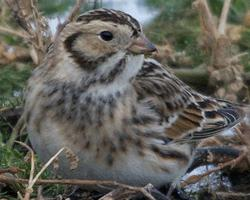
Stav ohrožení
| Ohrožen |
Popis zvířete
The Lapland Longspur, scientifically known as Calcarius lapponicus, is a captivating small passerine bird that belongs to the family Calcariidae. This species exhibits a remarkable adaptability to harsh climates, thriving in the tundra regions of the Arctic across North America, Europe, and Asia. It is particularly noted for its striking plumage and melodious song, features that make it a subject of interest among bird enthusiasts and researchers alike.Physical Description:
The Lapland Longspur is a medium-sized bird, measuring about 14 to 16 cm in length, with a wingspan ranging from 22 to 26 cm. It exhibits sexual dimorphism, where males and females display different color patterns, especially during the breeding season. Males are adorned with a striking black face and throat, a rusty nape, and a white belly, while their back features a blend of brown and black. In contrast, females and non-breeding males have a more subdued coloration, predominantly characterized by brown and buff tones that offer excellent camouflage against the tundra landscape.
Habitat and Distribution:
The Lapland Longspur's breeding habitat is the Arctic tundra, where it nests on the ground, often in areas with low vegetation. During the winter months, it migrates to open fields, farmlands, and coastal areas in temperate and subarctic regions. This bird has a vast range, extending from Scandinavia across Siberia to Alaska and Canada, and migrating southwards to the United States, and even as far as Central Asia and Europe.
Behavior and Diet:
Lapland Longspurs are ground feeders, predominantly consuming seeds and insects. Their diet varies seasonally; they feed on insects and their larvae during the summer, which are abundant in the tundra, and switch to seeds in the winter months. These birds are known for their social behavior, especially in winter, when they form large flocks that can sometimes include thousands of individuals. This social structure is believed to offer protection against predators and aid in locating food.
Reproduction:
The breeding season begins in late spring or early summer when the snow starts to melt. The Lapland Longspur is monogamous, and pairs form shortly after males return to the breeding grounds. The female builds a cup-shaped nest on the ground, often concealed by vegetation or rocks. She lays 3 to 5 eggs, which she incubates for about two weeks. Both parents participate in feeding the chicks, which fledge approximately two weeks after hatching.
Conservation Status:
The Lapland Longspur is currently classified as Least Concern by the International Union for Conservation of Nature (IUCN). Despite facing threats from habitat destruction and climate change, which could impact its breeding and wintering grounds, the species benefits from a large range and population size that appear stable for the moment. Conservation efforts and monitoring are essential to ensure that this species continues to thrive in its natural habitat.
In conclusion, the Lapland Longspur is a resilient and fascinating bird species, whose life cycle and behavior are closely intertwined with the seasonal dynamics of the Arctic tundra. Its melodious song and vibrant breeding plumage make it a joy to observe, and its presence across vast territories underscores the importance of international conservation efforts to protect these birds and their habitats.
Podobná zvířata
Nové fotografie zvířat
Top 10 zvířat
- Dolphin gull (Leucophaeus scoresbii)
- Diana monkey (Cercopithecus diana)
- Moustached guenon (Cercopithecus cephus)
- Galápagos tortoise (Geochelone nigra complex)
- Russian tortoise (Testudo horsfieldii)
- Japanese macaque (Macaca fuscata)
- Stone loach (Barbatula barbatula)
- Greek tortoise (Testudo graeca)
- Common flying dragon (Draco volans)
- Colossal squid (Mesonychoteuthis hamiltoni)


